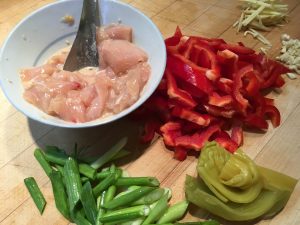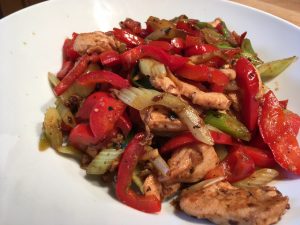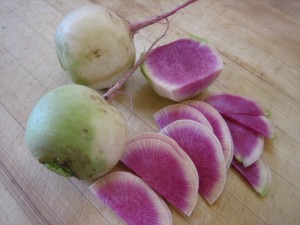 Most nights when I cook dinner, it’s usually an ad-lib effort based on what’s in the refrigerator. Last night I had some leftover raw chicken breast strips coated with a little cornstarch, wine, soy sauce, salt, and oil. There was also a week-old red bell pepper, a stray celery stalk, and some green onion. I thumbed through The Hakka Cookbook and found Stir-fried Chicken and Salted Mustard Greens on page 162. Bingo! I had all the ingredients plus some extras and the all-important pickled mustard greens, beloved by the Hakka.
Most nights when I cook dinner, it’s usually an ad-lib effort based on what’s in the refrigerator. Last night I had some leftover raw chicken breast strips coated with a little cornstarch, wine, soy sauce, salt, and oil. There was also a week-old red bell pepper, a stray celery stalk, and some green onion. I thumbed through The Hakka Cookbook and found Stir-fried Chicken and Salted Mustard Greens on page 162. Bingo! I had all the ingredients plus some extras and the all-important pickled mustard greens, beloved by the Hakka.
 Basically, it is a chicken stir-fry with the addition of salted or pickled mustard greens and red bell pepper for color. The recipe includes a sauce mixture with a little sugar and vinegar that gives the finished dish a slight sweet-sour tang. I stir-fried the chicken with ginger and garlic, then added the vegetables. At the end, I added a tiny bit of water and skipped the sauce since I used pickled mustard greens which were already a bit sweet and tangy. Here are my results. Quick, easy, and delicious.
Basically, it is a chicken stir-fry with the addition of salted or pickled mustard greens and red bell pepper for color. The recipe includes a sauce mixture with a little sugar and vinegar that gives the finished dish a slight sweet-sour tang. I stir-fried the chicken with ginger and garlic, then added the vegetables. At the end, I added a tiny bit of water and skipped the sauce since I used pickled mustard greens which were already a bit sweet and tangy. Here are my results. Quick, easy, and delicious.


